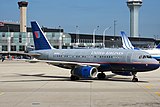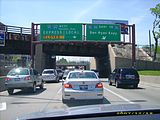Transportation in Chicago


Chicago, Illinois, is the third-largest city in the United States and a world transit hub. The area is served by two major airports, numerous highways, elevated/subway local train lines, and city/suburban commuter rail lines; it is the national passenger rail hub for Amtrak routes, and also the main freight rail hub of North America.
Surface transportation networks and public ways within the city are the responsibility of the
Airports
- O'Hare International Airport, which is the second busiest airport in the world by one measure[citation needed], is a major airport serving numerous domestic and international destinations. It is a hub for United Airlines and American Airlines. Construction is underway for a major expansion. This airport is statistically one of the busiest in the United States.[citation needed]
- Midway International Airport serves primarily domestic destinations, Toronto, and select Mexican cities. It is a major focus city for Southwest Airlines.
- Chicago had a third airport, Meigs Field, until it was demolished in 2003.
There are several other smaller commercial airports in the Chicago area, these include:
- National Guard has constructed facilities to base their Chicago metropolitan areaair operations here as well.
- Chicago Rockford International Airport in Rockford, which supports scheduled passenger airline service to many cities in the United States and many cargo flights. Rockford officials are positioning the airport to attract customers from Chicago's western suburbs.
- A public heliport called Chicago Vertiport opened in 2015 near the Illinois Medical District.[1][2]
Suburban airports and airfields
| Name | IATA airport code |
ICAO airport code |
Location |
Aurora Municipal Airport |
AUZ | KARR | Sugar Grove, Illinois |
| Clow International Airport | 1C5 | K1C5 | Bolingbrook, Illinois |
| Chicago Executive Airport (formerly Palwaukee) | PWK | KPWK | Wheeling, Illinois |
| DuPage Airport | DPA | KDPA | West Chicago, Illinois |
| Lewis University Airport | LOT | KLOT | Romeoville, Illinois |
| Schaumburg Regional Airport | 06C | (none) | Schaumburg, Illinois |
Waukegan Regional Airport |
UGN | KUGN | Waukegan, Illinois |
Proposed airports
- A Chicago south suburban airport has been proposed as a regional airport in far-south-suburban Peotone, Illinois.
Cycling

Chicago maintains a 290-mile network of bikeways - including shared use paths, cycle tracks, and bike lanes - for private, public, and commercial bicycle use. Bicycles are allowed to operate on all Chicago roadways, except limited access highways.
A
Bicycles are available for rent at rental shops concentrated along the lakefront in the Loop and Near North Side community areas.
Several delivery companies operate bicycle courier services mainly in the Loop area.
Bicycles on transit
Bicycles are permitted on CTA buses via front-mounted bicycle racks and onboard CTA trains weekdays excluding the rush hours from 7 to 9 a.m. and 4 to 6 p.m. On weekends and holidays, bicycles are allowed on trains all day except for special events.[5]
Bicycles are allowed onboard Metra commuter rail service during off-peak and non-event times and in reverse peak directions during rush hours.[6]
Bicycles are only allowed on designated South Shore Line commuter rail service trains as part of a pilot program active during non-winter months.[7]
Bicycles are allowed on water taxis during off-peak and weekend hours.[8]
Transit systems
Chicago Transit Authority
The Chicago Transit Authority, or CTA, one of three service boards within the Regional Transportation Authority, operates the second largest public transportation system in the United States (to New York's Metropolitan Transportation Authority) and covers the City of Chicago and 40 surrounding suburbs. The CTA operates 24 hours a day and, on an average weekday, 1.6 million rides are taken on the CTA.

CTA has approximately 2,000 buses that operate over 152 routes and 2,273 route miles (3,658 km). Buses provide about 1 million passenger trips a day and serve more than 12,000 posted bus stops. The city's rapid transit system, known as the "
Chicago is one of the few cities in the United States that provides rapid transit service to two major
Bus services
Suburban
Pace, another service board within the Regional Transportation Authority, operates a primarily-suburban bus service that also offers some routes into Chicago.
Pace came into existence in 1985 under that name, and as an operating agency in 1995. It absorbed routes previously operated by a suburban town (e.g., Wilmette Wilbus) or a private company. Suburban operators ran into the same funding problems as those operating inside Chicago and evoked a similar response from area governments. Pace is the regional public sector response to keep local and regional bus service available in the Chicago metro area.
With its vast service area, Pace has a weekday daily ridership of 1,195,308 in November 2023.[9]
Inter-city
Several intercity bus companies offer service to other cities in Illinois and across the United States. Most operate to and from the Greyhound Lines terminal, located at 630 West Harrison Street (corner of Des Plaines Street). Greyhound Lines operates the majority of the inter-city bus service to and from Chicago, with routes connecting Chicago with Indianapolis, Cincinnati, Louisville, Nashville, Atlanta, Cleveland, Pittsburgh, Washington, New York, Detroit, Toronto, Milwaukee, Green Bay, Madison, Minneapolis, St. Louis, Memphis, intermediate points, and connecting with other points beyond. Both Barons Bus Lines and Miller Transportation connect Chicago with Fort Wayne and Columbus. Indian Trails connects Chicago with Kalamazoo, Lansing, Flint, and Bay City. Burlington Trailways connects Chicago with Rockford, Dubuque, Davenport, Burlington, Des Moines, Omaha, and Denver.
Other inter-city bus companies use their own separate inter-city bus terminals. Megabus, a subsidiary of Coach USA, departs from a curbside bus stop near Union Station, on Canal Street south of Jackson Boulevard, and connects Chicago with Indianapolis, Cincinnati, Louisville, Nashville, Cleveland, Columbus, Cleveland, Detroit, Milwaukee, Madison, Minneapolis, Des Moines, Omaha, St. Louis, Memphis, Kansas City, intermediate points, and connecting with other points beyond. Van Galder Bus Company, another subsidiary of Coach USA, departs from a curbside bus stop at Union Station, on Canal Street north of Jackson Boulevard, and connects Chicago with Rockford and Madison. Several bus companies catering to Hispanic passengers connect Chicago with points in Texas, and with connections throughout Mexico. These companies include El Expreso Bus Company, Omnibus Express, Los Paisanos Autobuses, Tornado Bus Company, Turimex Internacional, National Charter Bus,[10] Chicago Charter Bus Company[11] and GOGO Charters.[12]
Rail services
Commuter

The Metra Electric District is Chicago's oldest continuing commuter train (1856), and shares the railway with the
Inter-city
Amtrak owns and operates Union Station, the fourth-largest intercity passenger hub in the United States. The station is the focus of many of Amtrak's transcontinental routes. Unlike most of Amtrak's major stations, all trains calling at Union Station either originate or terminate there; passengers coming through Chicago must transfer to another train to reach their destination. It provides connections to Metra and the 'L.'
Before Amtrak's takeover of passenger service in 1971, trains ran out of Central Station, Dearborn Station, LaSalle Street Station and Chicago and North Western Terminal as well as Union Station.
Chicago Express Loop
The Chicago Express Loop is a proposed high speed rapid transit line connecting the Loop to O'Hare airport.[13][14][15]
Tourist trolleys
The City of Chicago offered free tourist trolleys that served the downtown area.[16] The "trolleys" were actually buses painted to look like historical streetcars. They ran every 20 to 30 minutes and served areas popular with tourists that did not have 'L' stations, such as the Museum Campus, Navy Pier, and the Magnificent Mile. The Free Trolley service was permanently discontinued in 2009.
The free trolleys should not be confused with the private-sector
Chicago public transportation statistics
The average Chicago commuter spends 86 minutes every day traveling to and from work on public transit. Of public transit riders, 28.% ride for more than 2 hours every day. On average, commuters wait at stops or stations for 15 minutes; 21% of riders wait for over 20 minutes. The average trip is 6.3 miles (10.1 km), while 28.% travel over 7.5 miles (12.1 km) in a single direction.[17]
Roads and expressways
Taxis
City and private initiatives have increased the proportion of hybrid and alternative fuel vehicles from less than one percent to over 74 percent of the city's cab fleet since 2008.[19]
Water
Chicago
Commercial shipping
The Port of Chicago, once centered on the Chicago River but since moved to the Lake Calumet area, is responsible for Chicago's commercial shipping traffic.[20]
Passenger ferry service

Passenger ferry service in Chicago is handled by commercial water taxis operating on defined routes on published schedules.
Shoreline Sightseeing offers water taxi service along the
Wendella Boats operates the Chicago Water Taxi which offers scheduled service along the Chicago River with stops at Michigan Avenue, Clark Street, Madison Street (Ogilvie and Union train stations), Chicago Avenue, North Avenue, and Ping Tom Park in Chinatown.
Recreational boating
Recreational boat traffic in Chicago includes tour boats, sailboats, powerboats, electric boats, canoes, and kayaks. This traffic originates from numerous private and commercial marinas and slips, and the Chicago Park District operates a municipal harbor system for the seasonal storage of recreational watercraft in Lake Michigan. With accommodations for 6000 boats, it is the largest system of its kind in the nation. Boat rentals are available on both the Chicago River and within harbors on Lake Michigan.
See also
- Chicago City Railway
- Taxicabs of Chicago
- Chicago Traction Wars
- Plug-in electric vehicles in Illinois § Chicago
References
- ^ Huber, Mark. "Construction Under Way at Two New Chicago Heliports" AINonline, 14 October 2014. Accessed: 19 October 2014.
- ^ Mark, Robert P. (2 May 2015). "Chicago Vertiport Opens for Business". Aviation International News. Retrieved 6 May 2015.
- ^ "Mitchell Offers Delay-Weary Chicago Travelers Timely Alternative". Mitchell Memo. Mitchell International Airport. September 2004.
- ^ "ABOUT DIVVY". Divvy. Retrieved 22 June 2016.
- ^ "Bike & Ride". Chicago Transit Authority. Archived from the original on 6 February 2018. Retrieved 6 February 2018.
- ^ "Bikes on Trains". Metra. Archived from the original on 6 February 2018. Retrieved 6 February 2018.
- ^ "Bikes on Trains". South Shore Line. Archived from the original on 6 February 2018. Retrieved 6 February 2018.
- ^ "Frequently Asked Questions". Chicago Water Taxi. Archived from the original on 6 February 2018. Retrieved 6 February 2018.
- ^ "Ridership Statistics: Pace Bus Summary". Regional Transportation Authority Mapping and Statistics (RTAMS). 2024. Retrieved January 19, 2024.
- ^ "Bus Rentals in Chicago". www.nationalbuscharter.com/chicago-charter-bus.
- ^ "Charter Bus Rentals in Chicago". www.chicagobuschartercompany.com.
- ^ "Group Transportation in Chicago". www.gogocharters.com/chicago-charter-bus.
- ^ Ruthhart, Bill and John Byrne (June 14, 2018). "Chicago taps Elon Musk's Boring Company to build high-speed transit tunnels that would tie Loop with O'Hare". Chicago Tribune. Retrieved June 14, 2018.
- ^ Mullen, Jethro (June 14, 2018). "Elon Musk's Boring Company to build high-speed Chicago airport link". CNN. Retrieved June 14, 2018.
- ^ McBride, Sarah (June 13, 2018). "Elon Musk's Boring Co. Wins Chicago Airport High-Speed Train Bid". Bloomberg. Retrieved June 14, 2018.
- ^ "Chicago free trolleys".[dead link]
- ^ "Chicago Public Transportation Statistics". Global Public Transit Index by Moovit. Retrieved June 19, 2017.
 Material was copied from this source, which is available under a Creative Commons Attribution 4.0 International License.
Material was copied from this source, which is available under a Creative Commons Attribution 4.0 International License.
- ^ "City Council Approves Mayor's Taxi Reforms". nbcchicago.com. Retrieved 21 July 2016.
- ^ "Chicago says taxi medallion auction to raise $18M". daily-chronicle.com. Retrieved 21 July 2016.
- ^ "Illinois International Port District - Overview/History". Illinois International Port District. Retrieved 22 June 2016.






